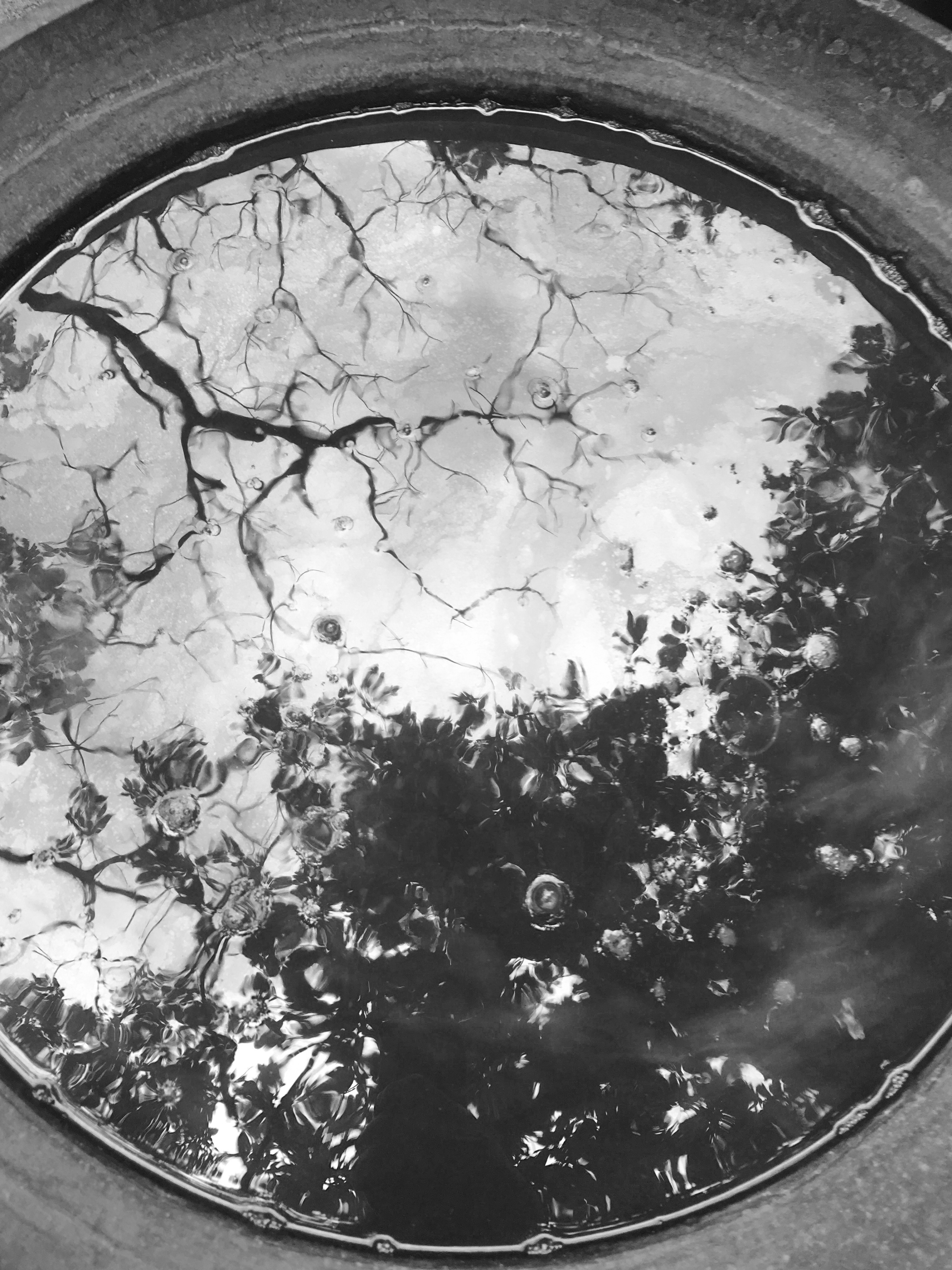Revelations From That Other World: Sahana
Thinking About The Environment Through Culture: Iriomote Fieldwork Report
By Sahana
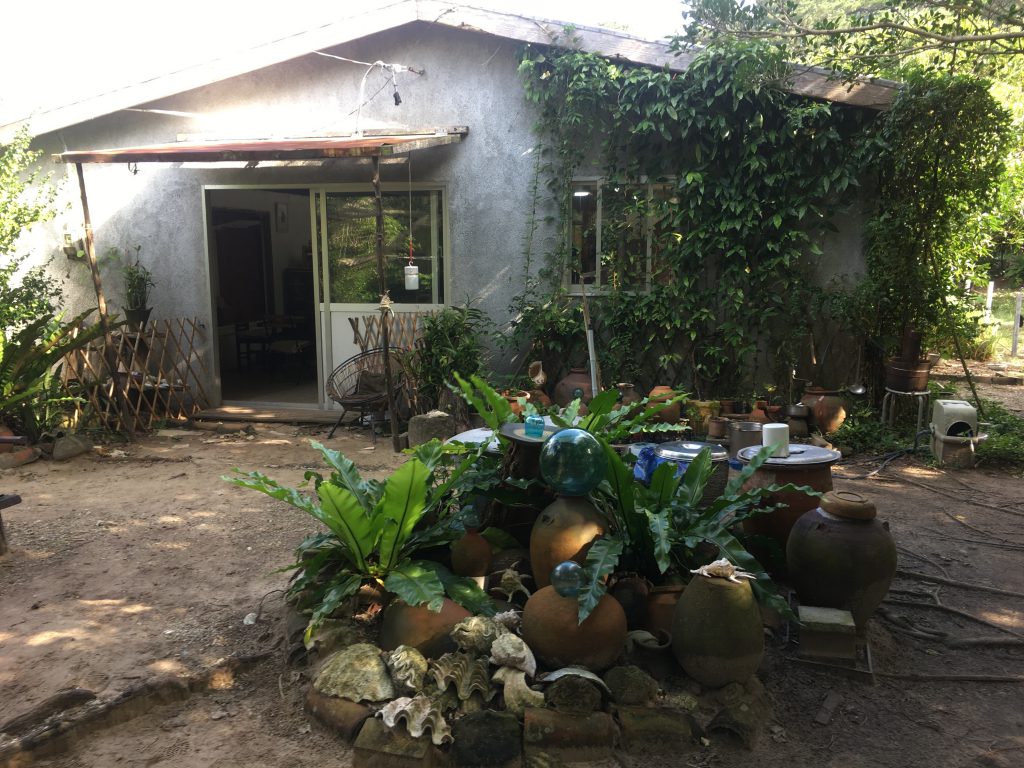
Kuuru Koubou (Studio Kuuru, Iriomote) where we experienced the creation of Okinawan handicrafts
Introduction & Thesis Statement
The intention of this report is to serve as a personal yet academically informative record of our class’ stay on Iriomote island, Okinawa, as part of our fieldwork assignment for the Waseda CIE’s ‘Thinking About The Environment Through Culture’ course, as part of the Waseda x Uehiro Foundation initiative.
In this report, I will lay down the experiences we all had, alongs with my personal impressions, the application of concepts we learned in class and ideas for future change.
Along with group of students whose broad research theme was the wildlife of Iriomote island, I and the others also had more specific areas of study that we chose on the basis of our own preferences. With a deep interest in food, dietary issues, nutrition, farm-to-table movement and health sciences, I decided to focus on the food culture and culinary practices of the Yaeyama island residents, and through this lens of analysis, obtain a better understanding of Iriomote island and its people’s relationship with the local economy, geography, political system, and socio-cultural values.
I hope the reader enjoys this piece, not just as an assignment, but as a heartfelt and sincere record of my unique travel and learning experiences.
December 23, 2017: Ishigaki Ajisai Restaurant
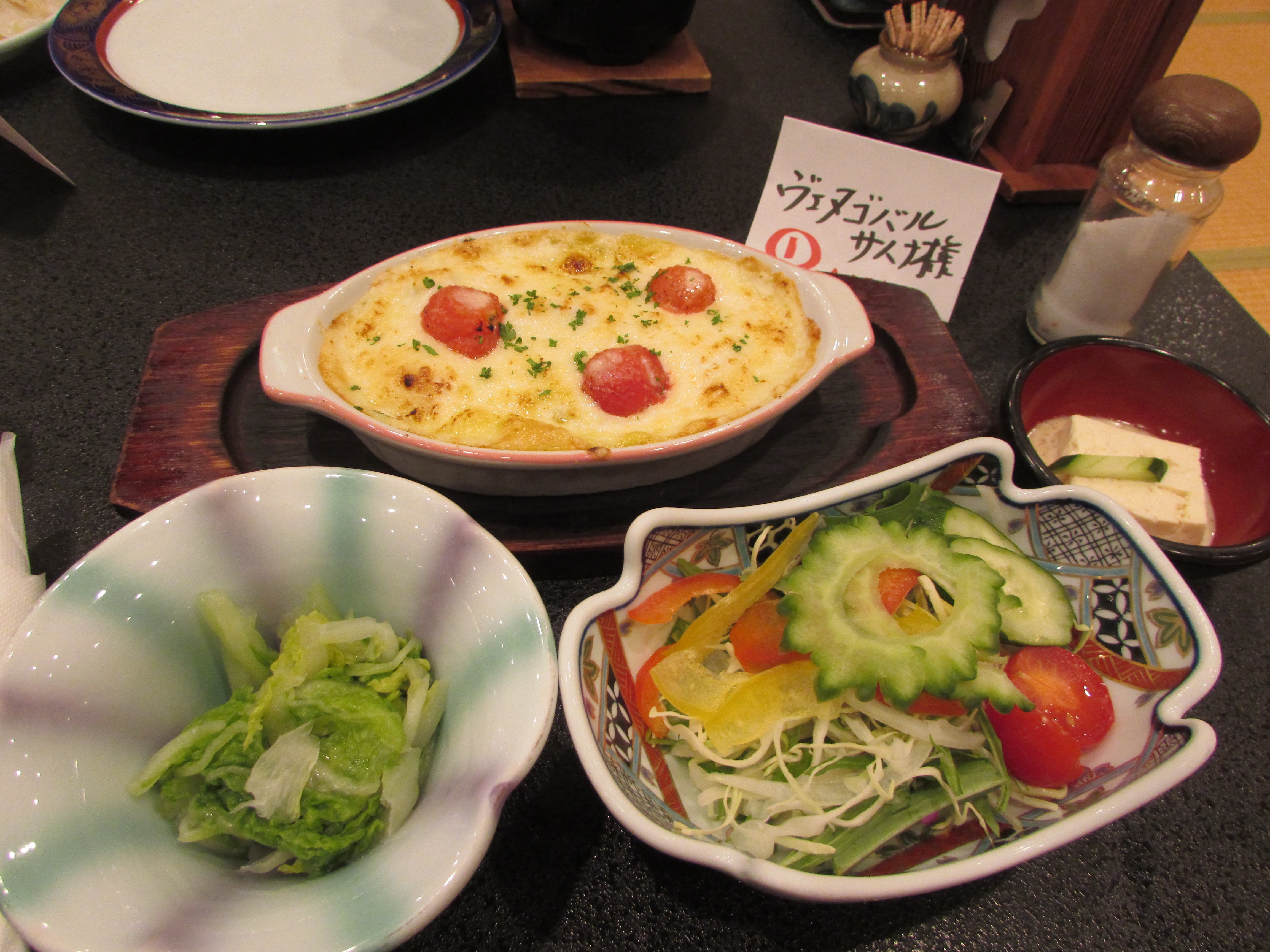
My first meal in Okinawa, featuring Shima Doufu (far right) and goya salad (bottom right)
I begin my fieldwork report with recounting the evening of our first day of travel, where we had an overnight transit on the Ishigaki island of the Yaeyama region, before taking a ferry the next morning to Iriomote, our intended site of study. I commence at this point in time, because it was where I had my first local learning experience. While being served traditional Okinawan multi-course meals, many of us commented that the consistency and texture of the local Tofu was different from that of the silken variety generally served in Tokyo eateries. (It did not immediately try to rip away from the dooming grasp of our chopsticks and actually held itself together while on the final journey to our mouths.) To this, our chef explained that since the water of Okinawa is more saltier and with higher mineral content than that of the inland reservoirs and water bodies used on the mainland of Japan for food manufacture, the texture of the islands’ tofu also tended to change as a result. In addition to this 島豆腐 (Island Doufu), we found out that the Yaeyama island group is also famous for a type of Tofu that is made out of peanuts rather than soy. As a sufferer of soy allergies, I was absolutely delighted by this offering and made a mental note to search it out through the next few days of our stay. (I pause here for a minute so the reader may take a moment to sympathize with the tragic plight of an Asian student who is unable to eat most kinds of soy sauce and tofu).
Using the opportunity to discuss more about Okinawan food habits with the chef, I learned that seaweed and rice are staple parts of the local diet, along with vegetables such as the bitter gourd (called Goya in the local language).
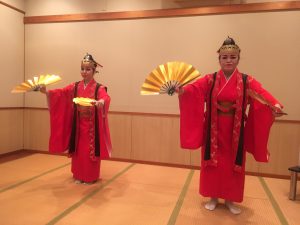

Dinner was accompanied by the restaurant arranging several exquisitely beautiful dance performances to educate us about Okinawa’s rich and festive culture. The first dance was meant to showcase the powerful grace of the eagle. The second one intended to and successfully captured the fluttering elegance of the butterfly. Finally, the performers came together and involved us all in a Kachashi dance chain around the room, to the accompaniment of lively music.
On the way back to our hotel, we noticed that many of the local signs, out of deference to the Okinawan language’s distinct identity, were written in the Japanese katakana instead of hiragana and kanji, clearly designating it as a separate linguistic system.
The first day of the trip, though merely a transit point, helped us settle down and learn to appreciate the intricacies of Okinawa’s unique environment, climate and cultural intensity. Through a simple dinner session, we were able to learn about the region’s cultural-artistic heritage and the unique characteristics of its cuisine (both food and drink).
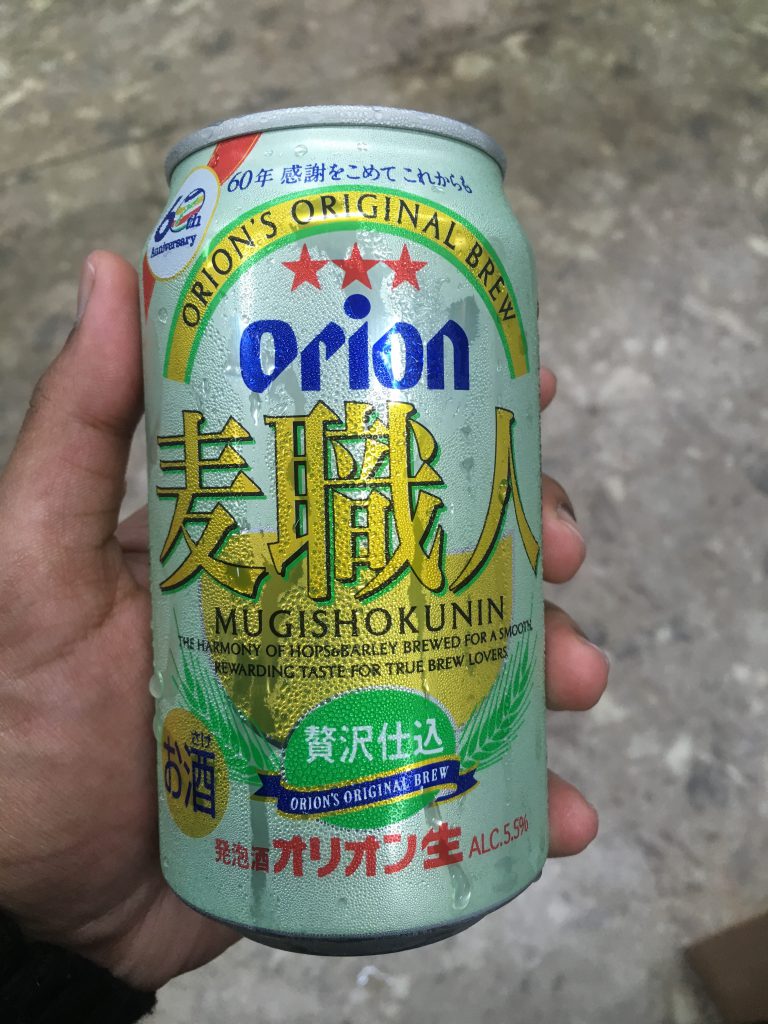
Orion Beer, Okinawa’s representative brew that’s famous all over Japan
December 24, 2017: Introduction to Iriomote Island
We reached Iriomote island by means of an hour long ferry ride. After that, there was another extended bus ride to reach the venue of our first field project but thankfully, the very talkative driver made the journey a lot more bearable. The mid-morning temperature, even at the close of the year, was sweltering and windows were thrown open so we could enjoy the salty sea air. “This is the southernmost part of Japan,” the driver announced and pointed to a map above his head. The place felt worlds away from the mainland, with its palm trees standing guard over the coast and bunches of tangled green mangroves sprouting out of the sea’s cerulean water.
I noticed that the bus was ambling even though the roads were practically deserted. As a result everyone was drowsy and sleepy and seeing this, the driver went on to explain the traffic regulations that had been put in place to protect the last 100-150 of the island’s indigenous Iriomote Mountain Cat [Japanese: 西表山猫・Iriomote Language: ヤママヤ] including but not restricted to frequent signage to warn drivers to slow down, traffic warnings to educate visitors, posts with helplines to assist injured animals, and entire stretches of speed bumpers for drivers to noisily warn any cats lingering on the roads. Our driver and guide went on to explain that with all these painstaking measures, the number of yearly deaths of the Iriomote mountain cats due to traffic accidents had come down from ten in 2016 to three in 2017.
First Fieldwork Assignment: Beach Pollution Survey
The bus dropped us off on a seemingly abandoned stretch of land but in a few moments, we were warmly met by representatives of the Iriomote Island Ecotourism Association who were there to help us conduct a survey of beach garbage on a nearby shore.
“Do you think Iriomote’s beaches are clean?” The activity leader asked and we looked at each other, suspecting that the answer to this would be a ‘no’, but not quite sure about the answer since it had looked pretty untouched from the window view of the bus. Furthermore, considering the island’s grand population of 2400 people, not to mention the eco-friendly consciousness of the community, how problematic could their beach pollution be? (Personally speaking, as an Indian, Japan’s worst beaches are at times cleaner than some of my country’s best and through years of desensitization, pollution for me has become anything that makes a place actively dangerous, as opposed to a few scattered wrappers or bottles.)
We headed down to the coast after being given cotton gloves and some trash bags, and were told that our job wasn’t to clean the beach per se but pick up only PET bottles we saw strewn around, for the purpose of sourcing and identification.
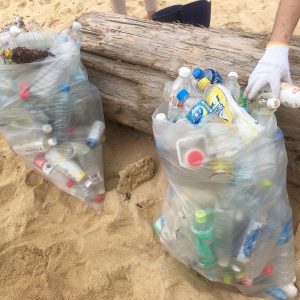
Some of the numerous PET bottles we found in a 5 meter radius
Breaking out from the cover of trees and foliage and onto the sand was nothing sort of shocking: there was garbage everywhere, ranging from dead birds and fish washed ashore to abandoned sheeting, bottles, medical debris, wrappers, boating equipment, food waste, party materials and unidentifiable pieces of trash that had floated in with the tides, covered in barnacles or algae. We were understandable distressed and even more so when our guides reminded us multiple times to focus on only the PET bottles for research and not begin an entire beach clean-up.
Within ten minutes, we had unearthed around 177 PET bottles and to our collective horror, many of these were not left behind by careless visitors or partygoers as we previously expected, but had drifted in from other countries entirely. We sorted them out by using either the language on the wrappers or any salvageable barcodes, finally establishing that most of the bottles had floated in from Taiwan, China and Korea. Some were local and yet others had survived ocean voyages from countries as far off as Vietnam and even Thailand.
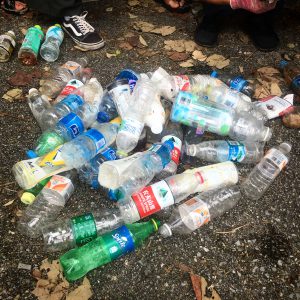
Identification of the bottles’ original countries, by label language and bar code
The group was understandably subdued while we sorted, sourced and totalled the bottles. While we had tea (served in re-suable plastic cups) and boxed lunch (served in paper cartons with wooden chopsticks, meant to be biodegradable), the guides explained the technical reality of wanting to be eco-friendly: after undertaking the arduous task of cleaning up the beach, local volunteers must sort out the garbage themselves and then bring it for processing to the plant on Ishigaki island, since Iriomote lacks the needed facility to do so. Transporting the trash comes with a heavy price for each ton, not to mention the cost of moving the waste in a sanitary manner and taking it on a ferry journey to its final destination.
It is needless for me to explain the injustice of this system, especially when taking into consideration the fact that a large majority of the garbage washed up on Iriomote’s shores are due to the irresponsible disposal methods of people in another country entirely. I was able to interact with our guides and in response to my question regarding the dangers of glass waste versus plastic, I was informed that though glass poses immediate danger to visitors and sea creatures, microscopic particles of plastic are absorbed by the aquatic system and its inhabitants and undergo biomagnification before then being ingested by humans. It was an unnerving session, to say the least.
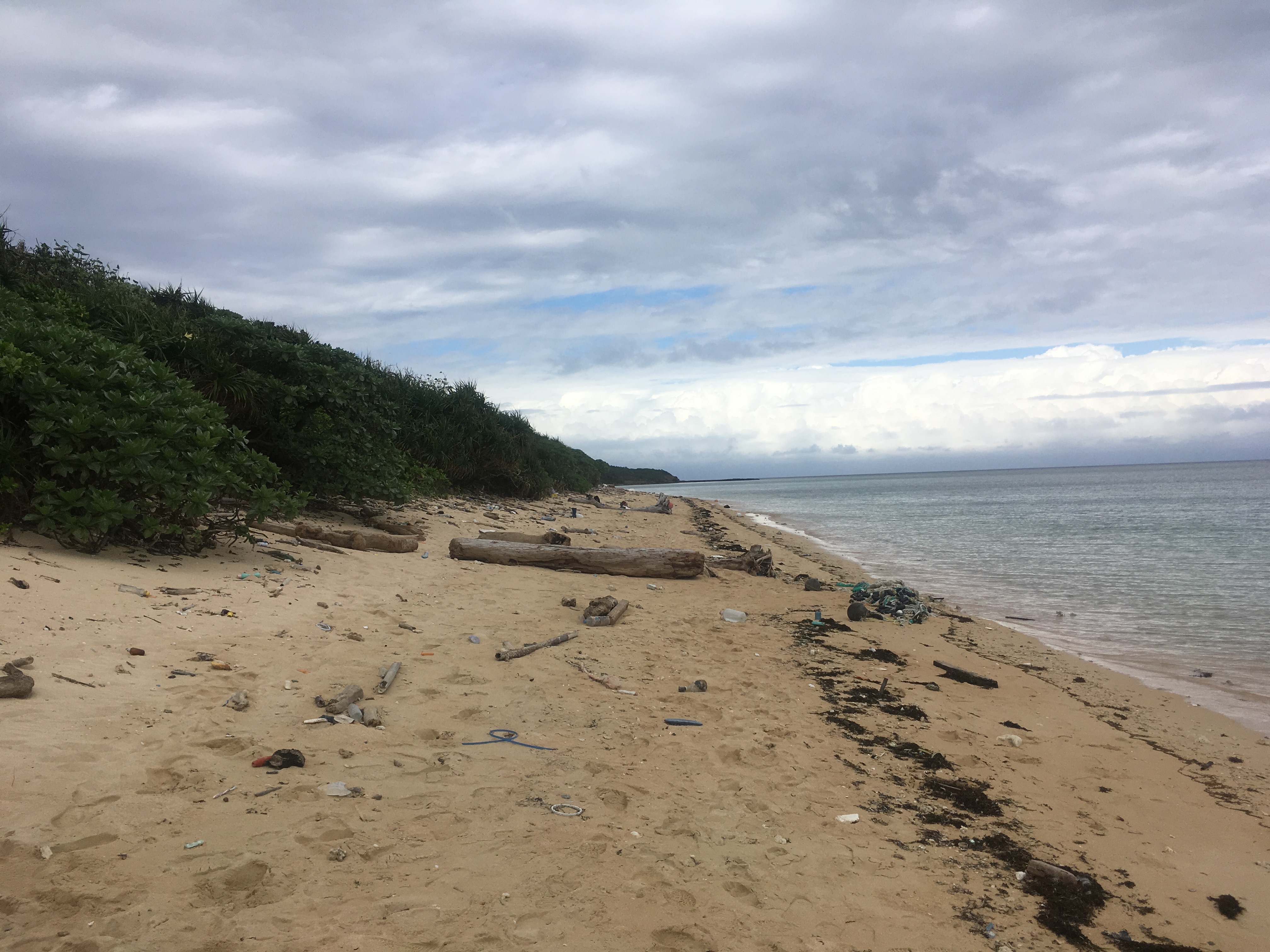
A local beach that suffers due to international pollution
Of all the experiences during the trip, surveying the beach for pollution was probably the most significant for me, as I stood there shell-shocked on a grey coast and realized that through a freakish intersection of time and circumstance, I was cleaning up after careless, laughing strangers whose faces I would never know. The only thing connecting us was the garbage in my hands, which had conquered vast bodies of water, stormy oceans and plummeting seas before it washed up at my feet, in no hurry to biodegrade any time this century. This activity really brought home the reality of pollution and how the seemingly meaningless actions of a single individual can have catastrophic effects on thousands of others we may never meet, whether we realize it or not.
Dinner that evening was in a small, homely dormitory-style hotel run by a husband and wife who welcomed us with brisk orders to take a bath before coming down to eat. Gone was the formalism of Tokyo, along with its glorious insinuations and politely disguised requests. Here, straightforward declarations were issued and subsequently followed.
During dinner, there were about five types of seaweed on my plate at one point during the meal and curious about this, I asked the chef more about the culinary habits of the island. He was delighted to answer and the passion with which he spoke about his food affected me as well.
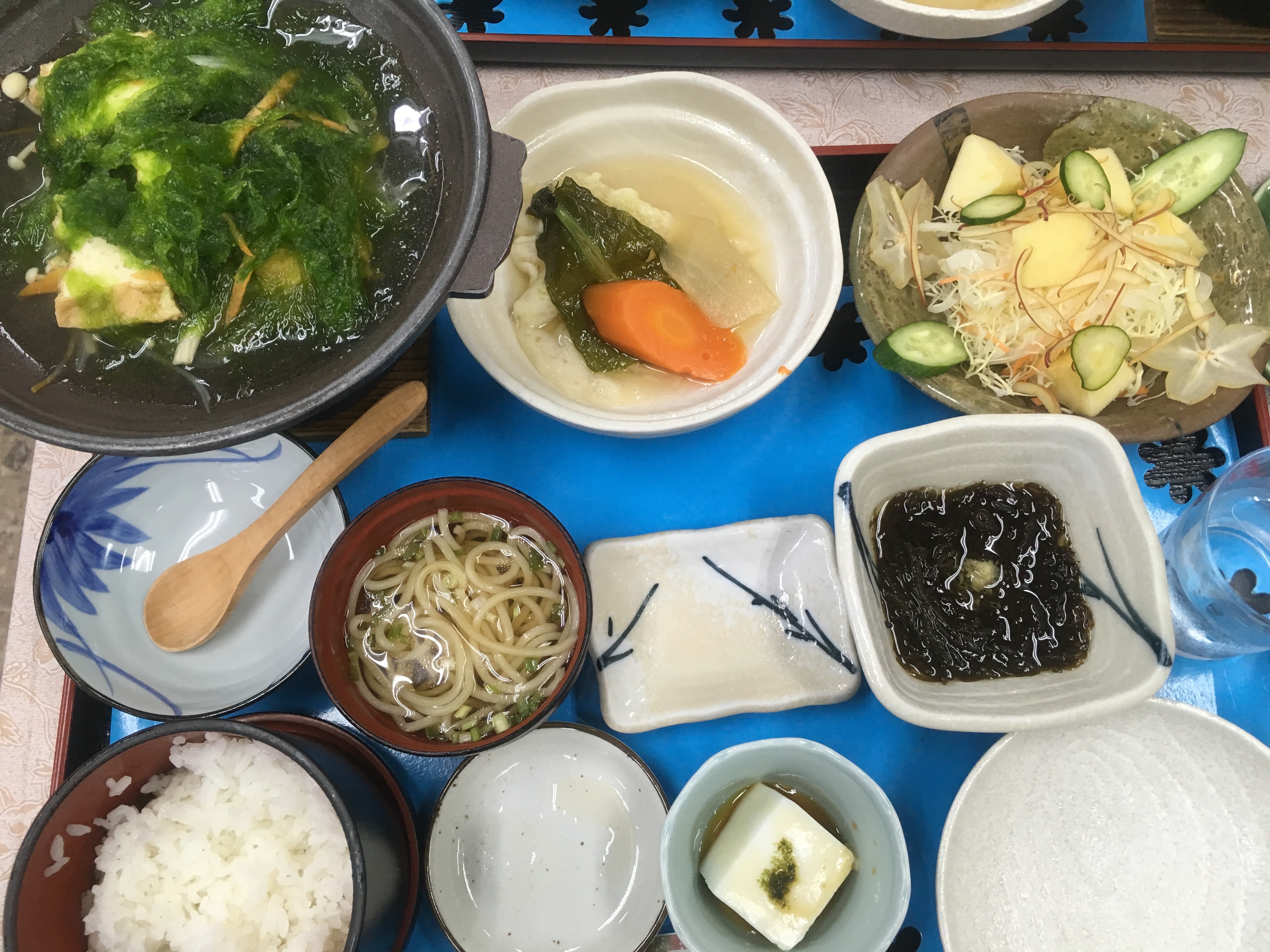
Note three varieties of seaweed, the thick soba noodles in kelp broth, and the firm island tofu
“Did you catch the seaweed yourself?” I asked through a translator.
“I did, by myself!” He confirmed, proud yet shy of the fact, and then went on to talk about how local regulations limit how much edible seaweed is allotted per person. He had personally caught this batch four to five months back and then processed it at home before cooking. The image of our chef wading into the deep ocean water to harvest seaweed with his own hands for our meal made me rather emotional, I admit, and I did my best to eat all of it, more conscious than ever of not wasting food that had been obtained through so much personal effort. Like the other chef in Ishigaki, he reiterated that seafood and vegetables make up most of the Iriomote diet and there is a scarcity of fruits.
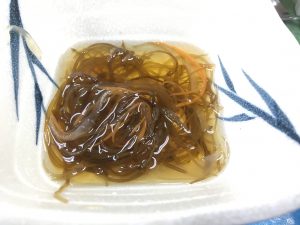
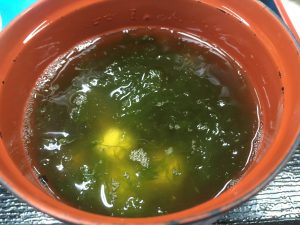
More locally harvested seaweed varieties that we enjoyed as part of our meal
After the hearty meal, we took a quick stroll to the nearby supermarket that yielded almost empty shelves with precious few stocked wares under the dim yellow lights. Beyond that stretch there was nothing but the sound of crashing waves, and pitch darkness. No streetlights, no luminescent road warnings, no neon shop advertisements and no flashing headlights. Why would there be? There were only around two thousand people living here, after all. Their day most likely started and ended with the sun. I remember it was terrifying yet awe-inspiring to behold that border between manmade lights and the all consuming darkness of nature. Stunned, I admired it for a few moments, observing the distinct lack of light pollution in a remote location like this, feeling that blackness coming closer and closer to engulf me as the night grew late…and then fled to my brightly-lit room.

Understanding the formidable power of nature and its ability to take over…anything
December 25, 2017: Christmas at Studio Kuuru
It was a surprisingly chilly day and we huddled around a wood fire that was blazing under a pot of bubbling red dye. Kuuru Studio was a small cottage surrounded by overhanging trees, energetic chickens and vats of colored liquid. This was the place where our amateur attempts at making traditional Okinawan textiles with vegetable-based dyes and banana fibre cloth were to come to life. Kinsei Ishigaki san and his wife Akiko Ishigaki san alternated between watching over our stewing masterpieces and answering our fervent questions about life, culture and society on Okinawa. Even as you read this, the husband and wife team are working to preserve Okinawa’s traditional dyeing art by introducing the activity to interested learners and foreign visitors, while also teaching them about the ties between decolonization, cultural appreciation and environmental preservation.
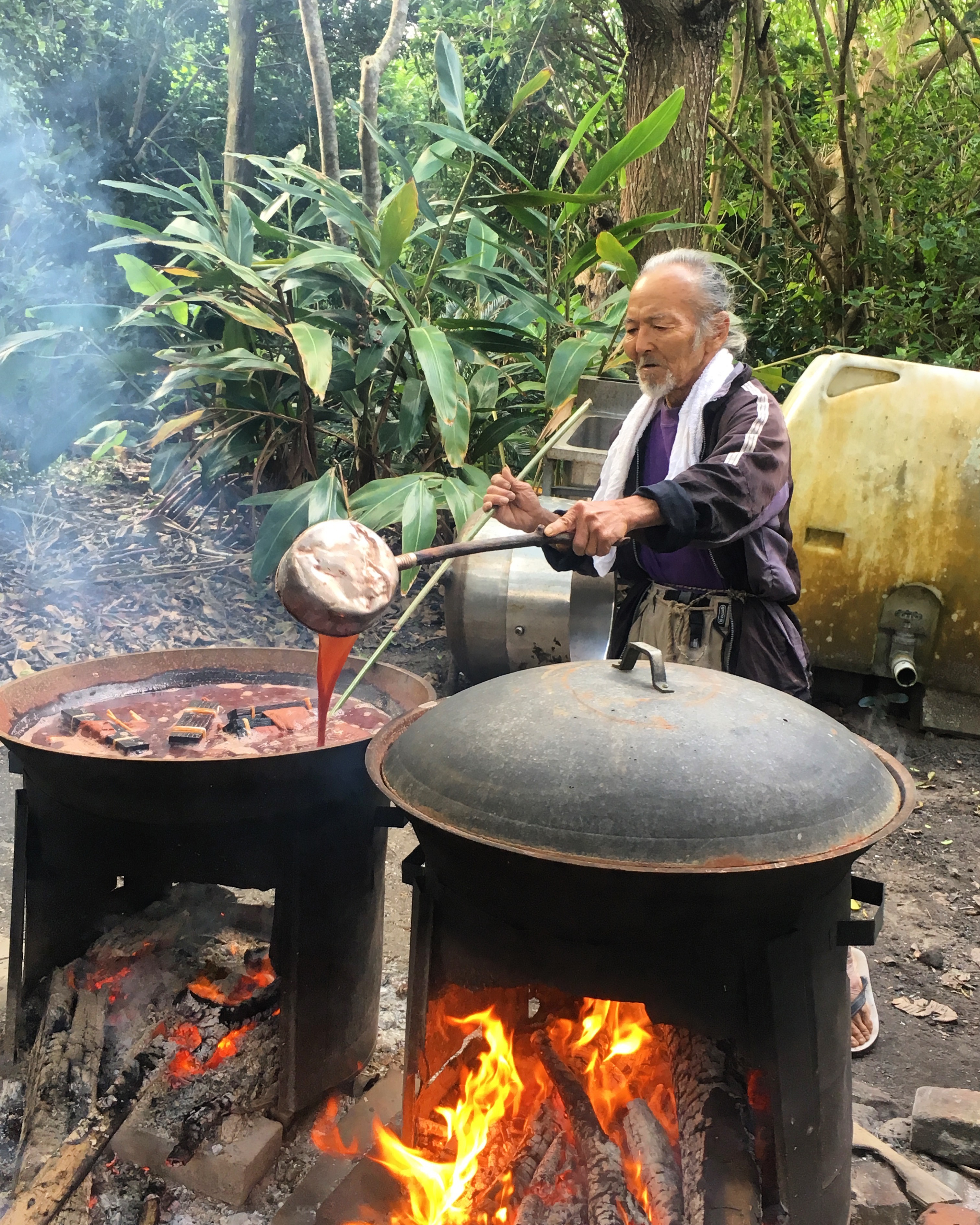
Ishigaki Kinsei san in his element, at the intersection of art and nature
That we were city kids was painfully clear, and even Ishigaki san was struggling not to laugh as he watched some of the students kneel to take photos alongside the boiling pot of dye like it was a celebrity. Observing his wife’s calm face, I couldn’t help but notice the simplicity of her home-dyed attire, the constant smile on her face, her utter lack of stress or tension and how her calm voice was always warm and welcoming. Was it her personality or the effect of living in such a serene, remote place?
For lunch, we got to sample more delicious local food and many of the students were infatuated with Akiko san’s lemongrass tea. In response, she simply came back with a clump of tied, fragrant fronds from her own garden and gifted them to the admirers.

After lunch, we headed out to canoe in groups and have an interactive lesson about mangroves. I was surprised by how well this first-hand learning method worked: where I once hated memorizing the features of mangroves for school exams, I now find myself easily remembering their classification and types after rowing up to them myself in Iriomote and getting to touch the roots, smell the leaves, and wade around the labyrinth of hugging trees in order to better understand their peculiarities.
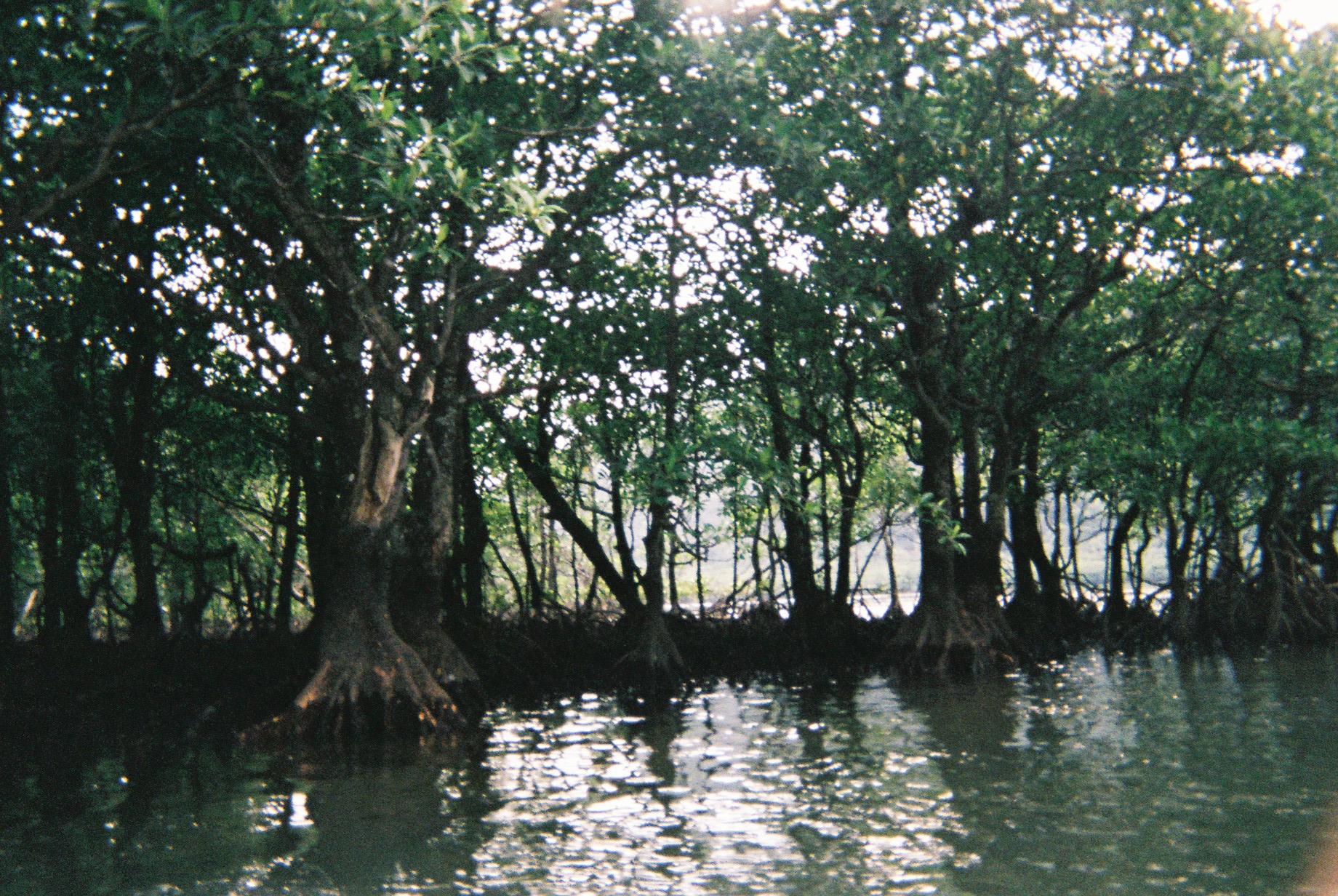
Mangrove roots immersed in water are thinner and softer than those above, which have a more sturdy structure
The views were simply ethereal, and having to canoe after one’s teacher in order to keep up with a botany lecture was an experience I’ll always cherish. We stopped in a narrow corridor at one point, disembarked from our boats and splashed our way onto a slope where a notice board had been set up. In a morose tone, our guide now switched to a history lesson and gave us an introduction to the sufferings of the Okinawan people under Japanese rule and in particular, the torture of indigenous locals and foreign labourers who were effectively kept as slaves to work on a mine in the island from the 1930s. Those who tried to escape either died of malaria, got lost in the jungle and starved to death, or were captured and then hanged in public to serve as an example. Left in a practically untouched state, there is now an information board to educate visitors about the history of this site, as well as a shrine to offer comfort to the souls of individuals who died under horrifying circumstances in a more regressive era.
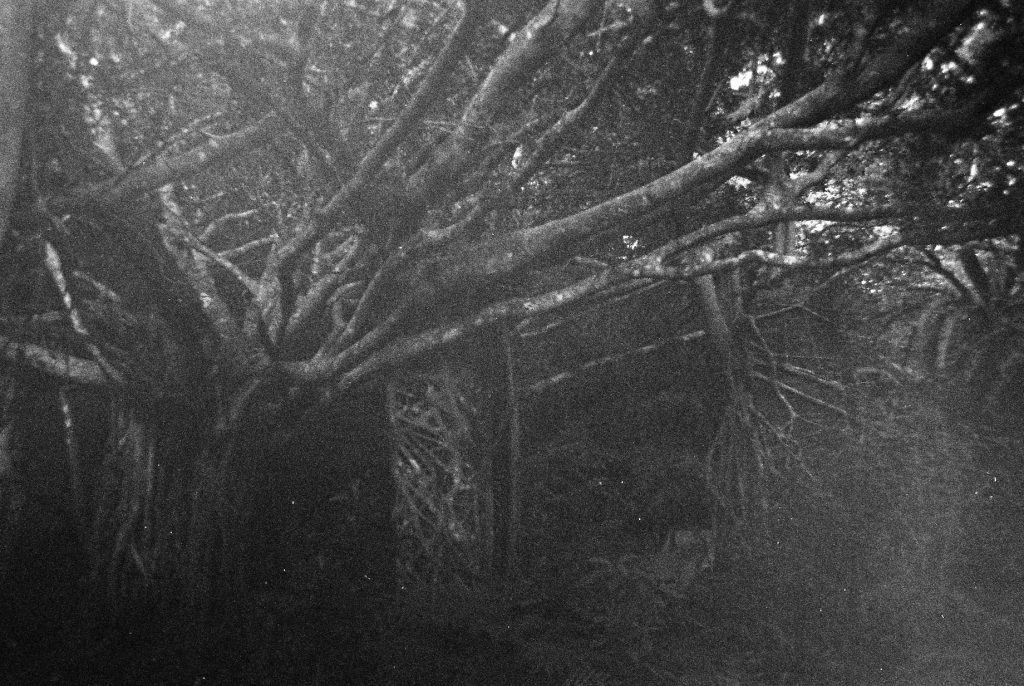
A section of the artificial mine structure that has been reclaimed by nature
Politics was on my mind that evening as we sat down after dinner to interview Ishigaki Kinsei san and Akiko san once more. Curious of the societal difference between mainland residents and those on the islands, I asked Kinsei san for his opinion on Japan’s current government, Abenomics and the upcoming Olympics.
“It’s terrible!” he exclaimed and refilled his sake as he spoke with fury, “I hate them [The LDP]! Abe is an embarrassment to Japan.”
Wide eyes and uncomfortable smiles went around the room as he went on to express his distaste for the TPP (Trans Pacific Partnership) as well.
“The Olympics?” I asked.
“It would be better if they never happened here!”

Ishigaki Kinsei san treats us to traditional and modern Okinawan songs on the Sanshin instrument
Kinsei san’s energy seemed to only increase as the sun went down and soon afterwards, he was giving us all medical advice (“One drink and one smoke a day, everyday, keeps you healthy lifelong!”) and job hunting tips (“Don’t look for a job; make your own!”). In response to my question about when Okinawa had ever felt liberated and enjoyed an easy existence under the Japanese administration, his reply was that it had never been so and that the Japanese government had been bullying Okinawan people for well over four hundred years.
Later, when I asked about how Kinsei san identified in terms of nationality, he declared that he was neither Japanese nor Okinawan, but rather, from Yaeyama or Iriomote. He went on to demonstrate the nearly unintelligible Iriomote dialect, which even the native Japanese speakers of our group were struggling to decrypt. As the evening went on, I asked him and Akiko san about their image of an ideal world.
“Everything’s fine just the way it is now!” Kinsei san declared, “I hope it never becomes like Tokyo!”
I winced as my beloved city was then verbally abused for several minutes.
“Though I like the way things are now,” Akiko san admitted slowly when her husband had finished, “some more konbinis would be nice. I also dream of an artist’s village on Iriomote, as well as a university for our young people.”
“You don’t need that!” Kinsei sei interjected and fixed me with a look, “We have an excellent University already!”
“Really?”
“Yes!” He declared, “The best in the world! It’s the Iriomote University. The professor is the mountain cat and the classroom is in the forest.”
It took me a few moments to get the joke.
That night, however, I did a lot of thinking while trying to keep well away from the tropical geckoes playing on my bed that (unfortunately for me) were not considered household vermin to be exterminated the way they are in my country, but rather as guardians of the Okinawan home.

A card provided by the hotel, asking guests not to be terrified of the lizards (or terrify them)
The Iriomote Island Hotel was not really the most luxurious of accommodations, I had to admit. With its ceiling leaks, fungal patches and dusty carpets, it reminded me of a backpacker’s hostel or dorm more than a hotel. My classmate and I discussed this and realized that we, as consumers and tourists, were literally the deciding force for the future of such sanctuaries left on planet Earth. Surely, with more world attention and international interest, private sector companies might take up the opportunity to compete and then build a large business style hotel on Iriomote where companies could have their corporate getaways or noisy students could conduct their club field trips, but that would be devastating for local livelihood, the untouched landscape, the endangered Yamaneko and dark jungles and mangroves from where residents can still admire the galaxies, harvest their own food from (relatively) clean waters and protect their serene way of life.
In my opinion, future tourism efforts on Iriomote should not attempt draw in more visitors, but rather, discourage everyone except the most eco-conscious of travellers and learners who would willingly sacrifice their cosmopolitan comforts in order to take part in the island’s natural way of life and cause as little disturbance as possible to the environment before departing. As predicted, the governmental initiative to have Iriomote island designated as a UNESCO World Heritage Site is being met with apprehension if not outright opposition from the locals of the island who see through promised benefits and financial gain and worry about the environmental consequences of such a monumental change.
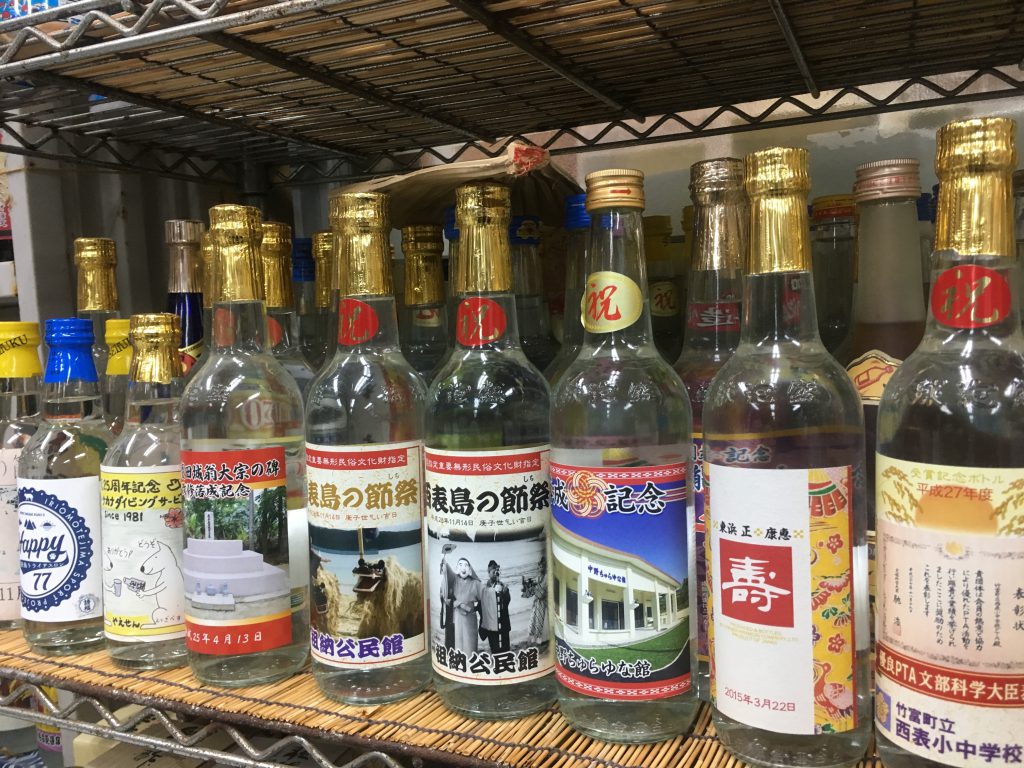
Fourth from the right, the bottle label shows a festival to honor Miroko sama, the God of the Iriomote people who is considered a form of Maitreya in Buddhism
December 26, 2017: Return to Tokyo and Reflections
Our departure was preceded by a trip to a facility that studies the Iriomote Yamaneko in painstaking detail and we received a presentation from an expert who outlined the challenges of their effort to save the endangered species and how working hand-to-hand with the locals and combining technological expertise with traditional values helped them learn more about the cat’s activities and protect its place on the island.
Overall, the trip impressed upon me the need to involve local residents and defer to their better judgment when taking administrative decisions that could potentially affect their lives. After spending time with a few of the kind-hearted residents and listening to their stories, I too now hope that Iriomote will never become a UNESCO World Heritage site and that if it undergoes any improvement, such changes will be in favor of the reclusive 100 or so divine cats that prowl the mountains and protect the human residents.
From a cultural perspective, the locals of Iriomote ensured my utmost respect with their straight-forward manner of speech and uncensored expression of strong opinions. I had the feeling that Kinsei Ishigaki and Akiko san saw all of us as foreigners (albeit with differing levels of Japanese ability) and considered themselves outside the government set definitions of who is or isn’t a Japanese national. To see them taking pride in their environment, cultural festivals and even local goods was heartening and I think that they found the ideal balance between protecting their identity and embracing the advent of globalization; the husband and wife team revived their ancient traditions to fight the effects of colonization but they also gladly share their way of life with eager visitors from all over the world.
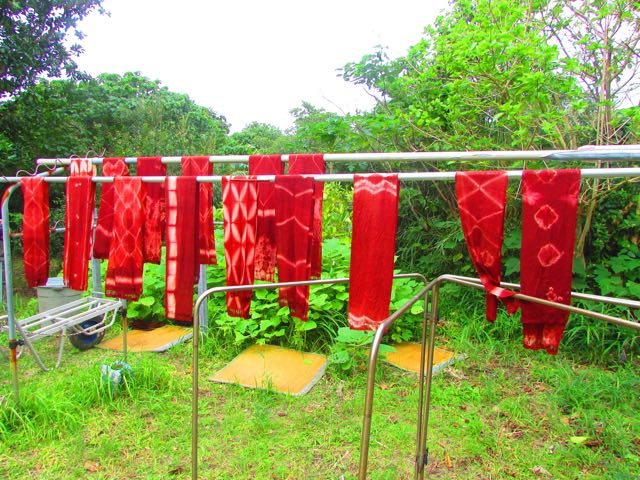
The final results of our learning experience under Ishigaki Akiko san’s able guidance
While I understand that there are many who desperately need a high-pressure, urban environment in order to thrive (and I am one such individual), people like us have a greater tendency to become oppressors as we begin to value personal profit over sustainability. We lose touch with our shared humanity and concern for others amidst cut-throat competition. Journeys and experiences like our fieldwork in Iriomote force us to confront the reality of the people who are most vulnerable to harmful effects of the policies we influence.
With this in mind, I aim to become a more socially conscious global citizen through my time as a student and further refine these values as I enter the working world.
Till then, I will sadly glide through many of Tokyo’s millions of shops, hoping to one day find a fresh batch of Yaeyama peanut tofu to enjoy and relive memories of that other unforgettable world.
Thank you for reading.

Hoshizuna Beach, Iriomote, just before a storm breaks

